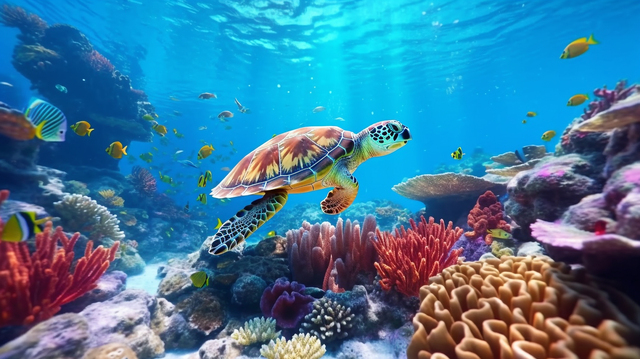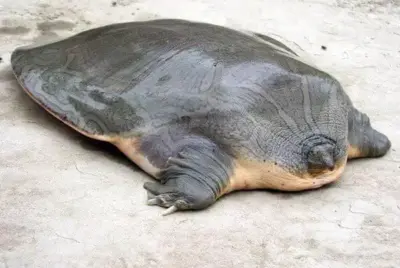The Different Types of Turtles & Why They Matter
Hello, fellow turtle enthusiasts! Isn’t it fascinating how many different turtle species grace our planet? From freshwater habitats to vast oceans, turtles have conquered them all. Today we’ll be exploring the many different types of turtles.
Let’s dive into this shell-tastic world!
Introduction to Turtle Types
Did you know there are over 300 species of turtles?
It’s mind-boggling, right?
Especially since most people think there are maybe only 1-20 different types of turtles.
These creatures range from tiny terrapins to massive sea giants. Whether you’re a newbie or a turtle connoisseur like me, there’s always something new to learn.
Why Turtles Matter
To many, turtles might simply appear as slow-moving creatures with a hard shell, basking in the sun or gliding through water. But their importance in the ecosystem and to humanity goes much deeper than their tranquil exterior suggests.
Before we get into some of the different types of turtles, let’s explore why these shelled wonders are truly indispensable.
1. Ecological Balancers
Turtles play a pivotal role in maintaining the balance in many ecosystems. In freshwater habitats, they help regulate populations by preying on certain species and serving as prey for others. By keeping certain populations in check, they ensure that no single species dominates the ecosystem, thus allowing various species to thrive together.
2. Seed Dispersers
Did you ever think of turtles as gardeners? Some terrestrial and freshwater turtles are herbivores or omnivores that consume a variety of fruits. Through their digestive system, seeds can get a protective coating and, once excreted, these seeds find themselves in new locations, ready to sprout. This seed dispersal aids in vegetation growth, promoting forest and wetland expansion.
3. Marine Ecosystem Engineers
Sea turtles, especially the Green Sea Turtle, graze on seagrasses. This grazing not only keeps the grass short but also ensures that the grass beds are healthy and productive. Seagrass beds are breeding grounds for many species of fish, crustaceans, and shellfish. By keeping these beds healthy, turtles indirectly support a rich marine biodiversity.
4. Symbols of Resilience and Longevity
Having roamed the Earth for over 200 million years, turtles have witnessed the evolution and extinction of countless species. They’ve endured ice ages, meteor impacts, and drastic climate changes. Their very existence is a testament to nature’s resilience and adaptability. In many cultures, turtles symbolize longevity, endurance, and the unwavering march of time.
5. Economic Value
In many coastal regions, turtles, especially sea turtles, are major tourist attractions. Turtle watching tours and conservation programs attract thousands of tourists annually. This not only educates the masses about these creatures but also brings significant revenue to local communities, thus incentivizing and funding further conservation efforts.
6. Cultural and Spiritual Significance
Turtles hold significant cultural and spiritual importance in various societies. Native American legends often depict turtles as the ‘Earth bringers,’ believing that North America was created on the turtle’s back. In Chinese culture, the turtle is a symbol of wisdom, endurance, and longevity.
7. Bioindicators of Environmental Health
Turtles, particularly freshwater species, are sensitive to environmental changes. Their health and population dynamics can offer insights into the health of the ecosystem. Declining turtle populations can act as an early warning system for potential environmental issues, prompting further investigations and actions.
In essence, turtles are nature’s unsung heroes, quietly ensuring that life, both in water and on land, flourishes. From supporting biodiversity to playing a role in cultural tales, their significance is vast and varied. And as turtle enthusiasts or simply as inhabitants of Earth, recognizing and championing their importance is our duty. After all, can we truly imagine a world without these ancient, shelled guardians?
Common Types of Turtles for Turtle Lovers
Sharing your home with a turtle can be a fulfilling experience. These serene reptiles not only provide companionship but also allow you to marvel at a piece of ancient wildlife, right in your living room.
If you’re thinking of taking the plunge into turtle parenthood, understanding the different types of turtles species suitable for homes is crucial. Here’s an expanded deep dive into some of the most popular choices and what you should know about each:
Red-Eared Slider
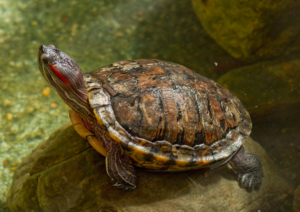
Origins: Native to the southern United States, these turtles have found their way into pet stores worldwide.
Diet: Omnivorous, they enjoy a mix of aquatic plants, insects, and even small fish.
Habitat Needs: They require a substantial water body to swim and a basking spot under a UV light. Remember, they can grow up to 12 inches, so a spacious environment is crucial.
Lifespan: With proper care, they can live up to 20-30 years.
Fun Fact: The ‘red ear’ marking is a small red stripe near their ears, giving them their unique name.
Painted Turtles
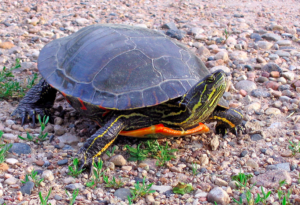
Origins: Widely distributed across North America, from Canada to Mexico.
Diet: Omnivorous diet consisting of aquatic vegetation, small fish, and insects.
Habitat Needs: Like the Red-Eared Slider, they need both water for swimming and a dry spot for basking.
Lifespan: They have a long life, typically ranging between 20-40 years.
Fun Fact: Their carapace has intricate, colorful designs, hence the name ‘painted’ turtle.
Russian Tortoise
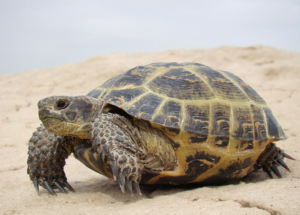
Origins: Found in regions spanning from Russia to Pakistan.
Diet: Herbivores, their diet mainly consists of leafy greens and occasional fruits.
Habitat Needs: Unlike aquatic turtles, these tortoises need a dry, spacious enclosure with hiding spots. They are also avid diggers, so a substrate for burrowing is essential.
Lifespan: They can live anywhere from 20 to 40 years.
Fun Fact: Despite their name, they’re not exclusively found in Russia.
Box Turtles
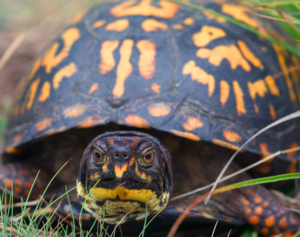
Origins: Indigenous to North America, particularly the eastern, central, and southwestern parts.
Diet: Omnivores by nature, they consume a varied diet from insects, worms, and berries to flowers.
Habitat Needs: They prefer a terrestrial environment with a mix of moist and dry areas. A shallow water dish is vital for them to soak.
Lifespan: It’s not uncommon for them to live up to 50 years with adequate care!
Fun Fact: They derive their name from their unique hinged shell, which allows them to completely close off, resembling a ‘box.’
African Aquatic Sideneck (West African mud turtle)
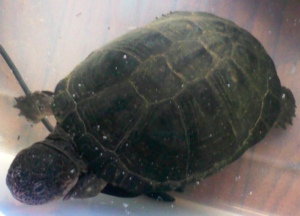
Origins: Native to the freshwater bodies of East and South Africa.
Diet: Primarily carnivorous, they feed on small fish, crustaceans, and aquatic insects.
Habitat Needs: They need a large aquatic space with a consistent water temperature. A basking area with UV light is also essential.
Lifespan: They typically live up to 25-30 years.
Fun Fact: Unlike most turtles, instead of retracting their heads into their shells, they tuck them to the side, thus the name ‘sideneck.’
Embarking on the journey of turtle parenthood requires dedication and understanding of the specific needs of each species. While their serene presence and curious eyes can brighten up your space, remember that they are long-term commitments, some living for several decades. The right care, environment, and love will ensure your shelled friend thrives in your company!
Unique Types of Turtles from Around the Globe
Our world is home to an awe-inspiring diversity of turtles. While some are familiar faces in pet stores or local ponds, others stand out due to their unique characteristics, habitats, and behaviors. These exceptional turtles, some of which are sadly facing extinction, truly demonstrate the wonders of evolution and nature. Let’s traverse the globe and discover some of these intriguing species.
Alligator Snapping Turtle

Origins: Native to freshwater habitats in the southeastern United States.
Distinguishing Features: Recognized for its immensely powerful jaws and distinctive worm-like appendage on its tongue, which it uses as a lure to attract prey.
Diet: Carnivorous, it primarily consumes fish but won’t shy away from small mammals or other turtles.
Conservation Status: Vulnerable due to habitat destruction and overharvesting.
Fun Fact: This species is one of the heaviest freshwater turtles, with some individuals weighing over 150 pounds!
Kemp’s Ridley Sea Turtle

Origins: Primarily found in the Gulf of Mexico, but can migrate to the Atlantic coast.
Distinguishing Features: Noted for its heart-shaped carapace and grey-green hue.
Diet: Mainly carnivorous, feasting on crabs, jellyfish, and mollusks.
Conservation Status: Critically endangered; their numbers have drastically decreased due to egg harvesting and accidental captures in fishing gear.
Fun Fact: This species engages in a synchronized nesting phenomenon called “arribadas” where thousands of females come ashore simultaneously to lay eggs.
Matamata Turtle
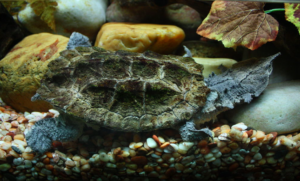
Origins: Native to the slow-moving freshwater streams and swamps of the Amazon and Orinoco basins in South America.
Distinguishing Features: Boasts a flattened, rough, and bark-like appearance, which aids in camouflage. The long, tubular snout functions like a snorkel.
Diet: Carnivorous, primarily consuming fish by way of ambush.
Conservation Status: Currently not endangered, but habitat loss poses a threat.
Fun Fact: “Matamata” translates to “kill, kill” in Spanish, likely referencing its efficient hunting strategy.
Indian Flapshell Turtle
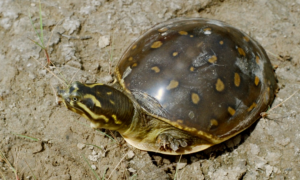
Origins: Found in freshwater habitats across the Indian subcontinent.
Distinguishing Features: This turtle possesses fleshy “flaps” on its plastron, which it uses to close its shell completely.
Diet: Omnivorous, consuming aquatic plants, insects, and small fish.
Conservation Status: Vulnerable due to habitat fragmentation and hunting.
Fun Fact: During dry seasons, they can dig into the mud and go into aestivation, a dormant state similar to hibernation.
Cantor’s Giant Softshell Turtle
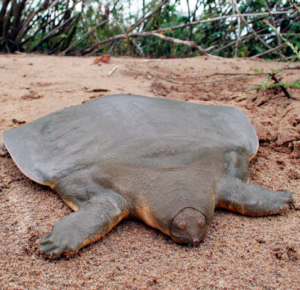
Origins: Native to the freshwater habitats of parts of Southeast Asia.
Distinguishing Features: Recognized for its broad, flattened body and the absence of a hard carapace. Instead, it sports a leathery shell. Many people mistake this turtle for having no turtle shell at all.
Diet: Carnivorous, with a preference for crustaceans, mollusks, and fish.
Conservation Status: Endangered due to habitat loss and hunting.
Fun Fact: Despite its imposing size, this turtle spends 95% of its life hiding under the sand, surfacing just twice a day to breathe.
This kaleidoscope of turtle species serves as a testament to nature’s creativity and adaptability. Yet, with many facing threats, there’s an urgent need for conservation efforts. By appreciating and protecting these unique turtles, we can ensure they continue to grace our world for generations to come.
Turtles: Conservation & Importance
Unfortunately, many types of turtles face threats. From habitat loss to climate change, our shelled friends need our help.
Current Conservation Status
Several turtle species are endangered. Why should we care? Because a world without turtles would be a world out of balance. And who would want that?
How You Can Help
Consider adopting a turtle from a rescue rather than buying. Or support conservation projects. Every bit helps, trust me!
Types of Turtles Conclusion
In the vast tapestry of nature, turtles shine brightly. As we’ve explored, the world of turtles is vast and diverse and has many different types of turtles. Each species, with its unique characteristics, plays a critical role in the grand scheme of things. As turtle lovers, it’s up to us to ensure they thrive for generations to come.
Types of Turtles FAQs
How long do turtles live?
It varies! Some can live for several decades, while others, like the Aldabra Giant Tortoise, can live for over 100 years!
Can all turtles swim?
Not all. Tortoises, for example, are land-dwellers and don’t swim.
Do turtles breathe underwater?
They hold their breath! Some species can stay submerged for hours by slowing their metabolism.
Are turtles and tortoises the same?
Not quite. While both are shelled reptiles, they have different habitats and habits.
Why are many turtle species endangered?
Loss of habitat, pollution, and climate change are some of the reasons. We must act to protect them!

